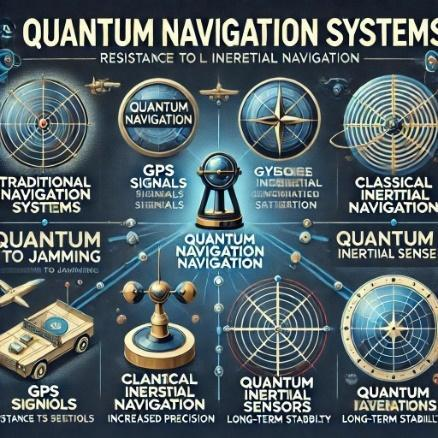A Technological Breakthrough in Navigation Without Satellites
Modern navigation technologies play a crucial role in aviation, maritime operations, autonomous transportation systems, and even everyday life. However, existing methods based on satellite signals have numerous limitations. Cutting-edge research in quantum physics offers the potential for a fundamentally new approach to navigation—one that is completely independent of external signals. This breakthrough could forever change the way we navigate through space.
Quantum navigation is not just an improved version of GPS; it is an entirely different method based on physical principles that ensure precision and independence from satellite systems. It enables location determination even in environments where traditional technologies fail: deep oceans, underground tunnels, and outer space. Such possibilities make quantum navigation a strategically important technology for the future of transportation, military applications, and even interplanetary exploration.
Why Is Traditional Navigation Vulnerable?
Current global positioning systems such as GPS (USA), GLONASS (Russia), Galileo (EU), and BeiDou (China) are widely used across various domains. However, despite their prevalence, they have significant drawbacks:
- Dependence on External Signals. Satellite signals can be blocked, jammed, or disrupted, making them vulnerable in strategically important regions.
- Instability in Space Environments. Electromagnetic bursts, solar storms, and other natural phenomena can interfere with satellite operations, leading to navigation failures.
- Limited Penetration Capabilities. Satellite radio signals cannot pass through water, concrete, or rock, rendering them unusable in underwater, tunnel, or subterranean environments.
- Reliance on Infrastructure. Navigation satellites require complex maintenance and are susceptible to failure due to malfunctions or targeted attacks on space assets.
- Economic and Geopolitical Risks. As satellite navigation is a critical infrastructure, any disruption or malfunction could have severe economic and military consequences.
These challenges drive researchers to explore alternative methods, with quantum navigation emerging as one of the most promising solutions.
How Does Quantum Navigation Work?
Quantum navigation is based on the principles of quantum mechanics, including superposition, entanglement, and quantum interference.
These phenomena enable unprecedented precision in measuring motion parameters, allowing for location determination without reliance on external references.
Key Components of Quantum Navigation
- Quantum Gyroscopes – Devices based on atomic interferometry that detect angular motion with accuracy far beyond that of traditional mechanical gyroscopes. This enables precise orientation tracking with minimal errors.
- Quantum Accelerometers – Sensors that measure acceleration using atomic wave interference. They detect even the slightest trajectory changes, allowing for precise movement calculations without external signals.
- Atomic Clocks – Instruments that utilize atomic energy level transitions to measure time with precision down to billionths of a second. These clocks ensure continuous synchronization, minimizing computational errors.
- Gravitational Sensors – Quantum devices capable of detecting variations in Earth’s gravitational field. These readings are compared with pre-mapped gravitational anomalies to refine location estimates.
- Magnetic Quantum Sensors – Instruments that register minute fluctuations in Earth’s magnetic field, enabling the use of the planet’s natural magnetic characteristics as navigation markers.
Principles of Quantum Navigation
Quantum gyroscopes and accelerometers track any changes in an object’s position. Their data is processed by an analytical system that calculates movement parameters and determines the current location using inertial navigation principles. Unlike traditional methods, quantum sensors exhibit significantly higher accuracy, preventing the accumulation of errors over long distances.
Atomic clocks provide ultra-precise synchronization, allowing the system to track time intervals with exceptional accuracy. Gravitational and magnetic sensors enhance the system by comparing measurements with established geophysical maps, enabling course corrections and eliminating potential deviations.
In environments where satellite navigation is unavailable—such as deep-sea expeditions, tunnels, and interplanetary missions—quantum navigation systems offer autonomous and precise positioning for extended duration’s without the need for external corrections.
Where Can Quantum Navigation Be Applied?
Aviation and Military Technologies
Military aircraft and drones could operate in environments where GPS signals are unavailable or deliberately jammed. In combat situations, this technology could provide a decisive advantage.
Space Missions
For interplanetary travel, quantum navigation could become an essential tool, allowing spacecraft to navigate without continuous communication with Earth.
Underwater Transportation
Submarines and autonomous underwater vehicles could navigate without surfacing, which is particularly valuable for scientific and military operations.
Autonomous Vehicles and Robotics
Self-driving cars and industrial robots could function in environments where traditional navigation methods are ineffective, such as mines, tunnels, or densely built urban areas.
Scientific Research and Seismology
Quantum sensors can detect changes in gravitational and magnetic fields, opening new possibilities in geology, archaeology, and earthquake prediction.
The Future of Quantum Navigation
Quantum navigation remains in the development phase, but in the coming decades, it could become the foundation for autonomous positioning systems. In the long run, this technology will ensure independence from satellite signals and revolutionize navigation across land, sea, air, and space.
Thus, we stand on the brink of a new technological revolution that will forever transform our understanding of spatial orientation.
